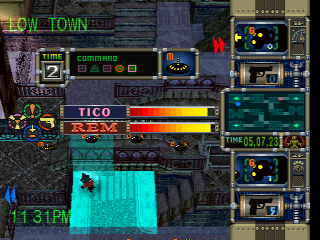

'Night Trap' Source: VarietyĪt the same time that Mortal Kombat was making money for Sega, they had their own controversy. Sega, however, released the game uncensored with a MA-13 rating and profited, with millions of users choosing their version over Nintendo’s sanitized Kombat.
#Hardcore gaming 101 night trap software#
In the end, game developers and publishers founded the Entertainment Software Rating Board, an independent group that reviews and rates games much like movies.įamily-friendly Nintendo got out ahead of the bad press and insisted that Midway change the color of the game’s blood sprays from red to white, so now when your character got punched in the face a splash of sweat would spritz out. Some lawmakers were advocating for government regulation of the industry, which would be a serious challenge to the First Amendment. Throw in gory special effects and “fatalities” in which players could rip each other in half and decapitate them and parents were less than pleased.īy 1994, Mortal Kombat was such a big deal that a Congressional hearing on video game violence was convened. The characters in this one-on-one fighting game were real actors who were photographed and digitized to lend the action a veneer of bloody brutality. One of the first games to really push this boundary was 1992’s Mortal Kombat, developed for the arcades by Ed Boon and John Tobias at Midway. 'Mortal Kombat' Source: AmazonĪs technology improved, video games crept closer and closer to realism, with some shocking effects. The arcade industry wouldn’t rebound until nearly a decade later, but that would bring its own challenges. Other towns used noise ordinances or obscure laws against coin-operated machines to prevent arcades from opening or run them out of business.īy 1983, a combination of closing arcades and overproduction led to the industry’s first major crash, driving several companies out of business. The city of Mesquite, Texas passed a law prohibiting minors under 17 from going to the Aladdin’s Castle video arcade without a parent. Everett Koop, Ronald Reagan’s Surgeon General, proclaimed to the press that kids were becoming addicted to arcade games “body and soul.” The city of New York began to shut arcades down,Īrcade bans weren’t limited to New York. Anecdotal stories of rises in crime and gang activity dogged arcades, and C. Parents started to get upset about the time and money kids were spending at arcades.

The Big Apple was home to one of the first major video game panics in the 1980s, when a handful of video parlors sprung up in Times Square. Parents have bemoaned their children being seduced by the lure of arcade games since the 1940s, when New York mayor Fiorello LaGuardia ordered the police to round up over 2,000 pinball machines and he had the newspapers take pictures of himself smashing them with a sledgehammer. New York’s Arcade Crackdown Source: Kelly Sikkema on Unsplash By end of 1977, though, the Death Race controversy was old news and the company stopped manufacturing the cabinets. For Exidy, though, this coverage was a windfall, and sales of arcade machines increased significantly. The game went on to garner media attention for the next year, with psychologists and parents weighing in on the potential harmful impacts of video game violence. The concept of vehicular manslaughter as a game mechanic – even with primitive black & white graphics – was enough to catch the attention of a reporter for the Associated Press, who wrote an article on it in 1976.

One or two players could steer on-screen cars with a wheel controller, and the goal of the game was to run over humanoid “gremlins” to earn points, at which point they’d be replaced by hazardous tombstones. One of the first games to inspire a significant amount of public pushback was Death Race, a primitive arcade game released by Exidy in 1976. Let’s take a trip back to see the games that stoked controversy in each decade. Even the most seemingly harmless arcade games were fodder for protests. Parents and the press have been stoking moral panic about video games since the early days of Space Invaders. While the science certainly isn’t proven, that hasn’t stopped the media and parents groups from decrying games as a net negative for our kids.Īs any gamer knows, though, this is nothing new. The recent classification of "gaming addiction" as an illness by the World Health Organization has kicked off a wave of articles examining the negative effects of electronic games on young minds.


 0 kommentar(er)
0 kommentar(er)
